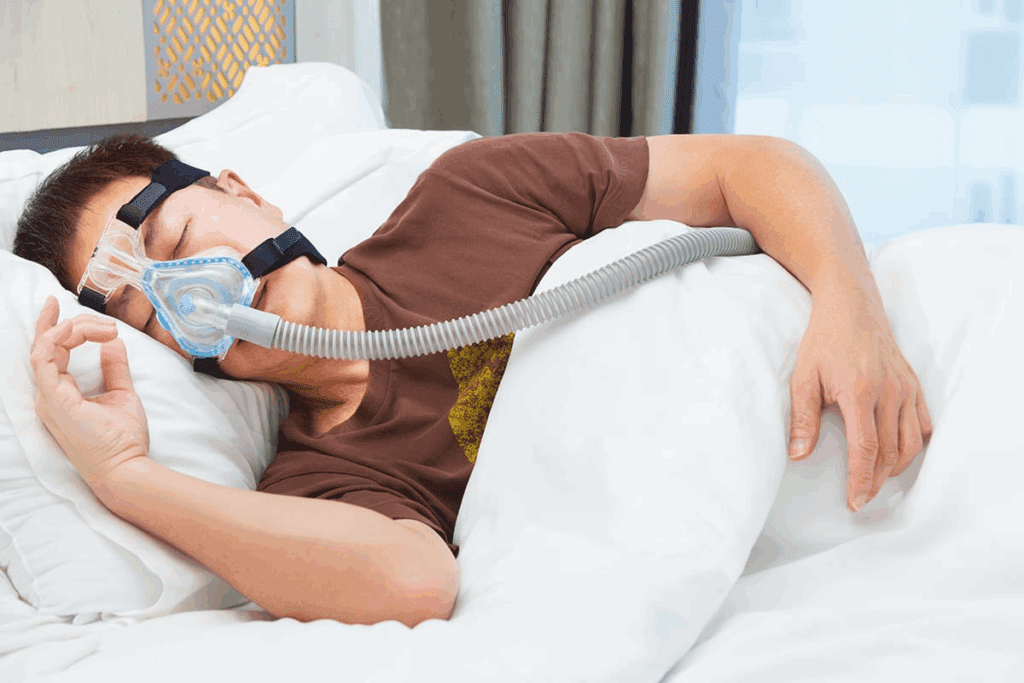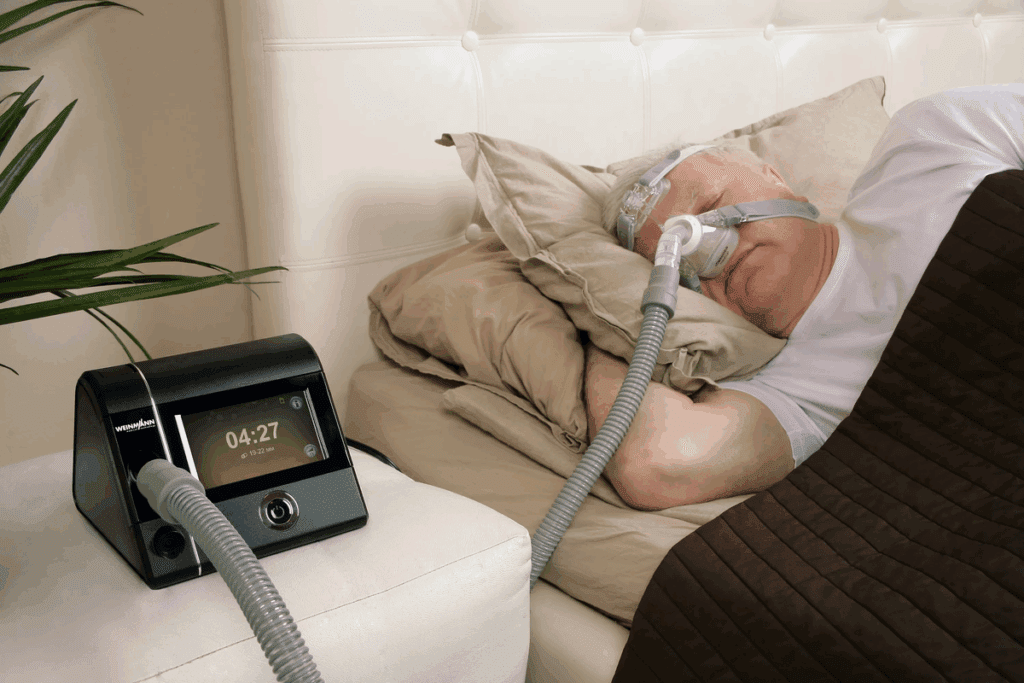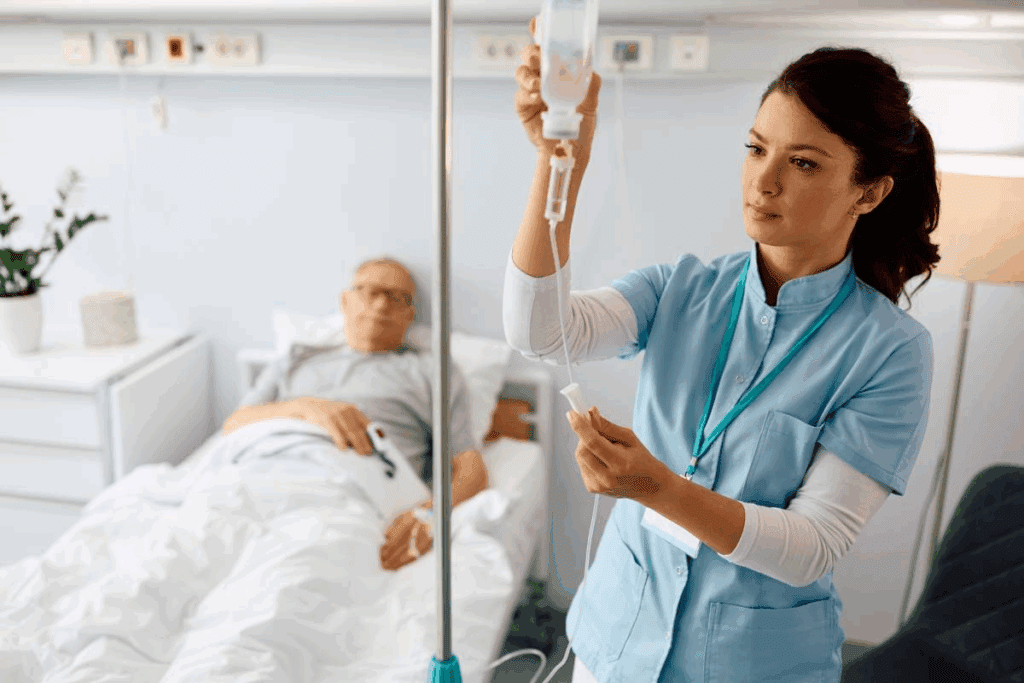Last Updated on November 27, 2025 by Ugurkan Demir

Obstructive sleep apnea (OSA) affects millions of adults worldwide. About 40% of patients stop using CPAP therapy because it’s uncomfortable and has side effects.
We know sleep apnea is a big health issue. While CPAP machines are the usual treatment, many find them hard to use and uncomfortable.
In this article, we’ll look at the best CPAP alternatives. We’ll talk about new, effective ways to manage sleep apnea. These include surgically implanted devices and custom oral appliances, all supported by research.
The 5 best sleep devices for sleep apnea that are alternatives or adjuncts to CPAP therapy, such as oral appliances.

Sleep apnea is becoming more common, and we need better treatments. This condition can harm our health if not treated.
In the U.S., 10% to 30% of adults have obstructive sleep apnea. It causes breathing stops during sleep, leading to poor sleep and low blood oxygen.
Sleep apnea can also lead to heart disease, diabetes, and brain problems. So, finding good treatments is key.
| Prevalence Group | Percentage Affected | Estimated Number |
| Adults with Obstructive Sleep Apnea | 10-30% | 25-75 million |
| Adults using CPAP Therapy | ~60% | 15-45 million |
| Adults Abandoning CPAP | ~40% | 6-18 million |
About 40% of patients stop using CPAP therapy because it’s uncomfortable. They might find the mask too tight, get dry mouth, or be bothered by the noise.
Because CPAP therapy has its limits, new treatments are being developed. These include MADs, APAP machines, and other options.
Knowing how common sleep apnea is and how CPAP therapy can be a problem helps us see the need for better options. We need treatments that are easier to use and work better for patients.

Sleep apnea treatment has moved beyond traditional CPAP machines. This offers patients more choices. The old CPAP therapy had its limits, leading to new treatments that better help patients.
CPAP machines have been the go-to for decades. But, many face issues like discomfort and noise. Now, doctors have found other ways to treat obstructive sleep apnea (OSA).
These new options include different PAP machines, oral appliances, lifestyle changes, and surgery. Oral appliances are often the first choice for those who can’t use CPAP. These modern solutions aim to meet each patient’s needs better.
Recent years have brought big changes in sleep apnea tech. These changes have greatly improved patients’ lives. Some key advancements are:
These new options give doctors more ways to treat sleep apnea. They can now choose the best treatment for each patient.
| Treatment Option | Description | Benefits |
| Oral Appliances | Custom-made devices that advance the lower jaw | Comfortable, easy to use, and effective for mild to moderate OSA |
| APAP Machines | Automatically adjust pressure levels | Flexible, comfortable, and suitable for patients with varying pressure needs |
| Inspire Therapy | Implantable device that stimulates airway muscles | Effective for severe OSA, minimally invasive, and improves quality of life |
As sleep apnea tech keeps getting better, we’ll see even more new solutions. These will help manage sleep apnea better and improve patient results.
MADs are a good choice for those who don’t like CPAP therapy. They move the lower jaw forward to stop the airway from collapsing. This helps reduce sleep apnea and snoring.
MADs fit each person’s mouth, making them comfortable and effective. They are silent, portable, and easy to use. This is better than big CPAP machines. They work well for people with mild to moderate sleep apnea.
The SomnoDent Fusion is a top MAD for its precision and comfort. It can be adjusted to move the jaw the right amount. It’s custom-made for each person, ensuring a good fit and treatment.
The VitalSleep Anti-Snoring Mouthpiece is great for reducing snoring and mild to moderate sleep apnea. It’s boil-and-bite for a perfect fit. It’s also affordable compared to other treatments.
MADs are good for people who:
It’s important to talk to a healthcare professional about MADs. They can help decide if a MAD is right for you. They consider how severe your sleep apnea is and what you prefer.
APAP machines are a big step forward in treating sleep apnea. They adjust air pressure levels automatically during the night. This makes them a better choice than traditional CPAP machines.
The ResMed AirSense 11 AutoSet is a top-notch APAP machine. It’s known for being comfortable and having advanced features. It includes:
The Philips Respironics DreamStation 2 Auto CPAP is also highly praised. Its main features are:
APAP machines have several benefits over traditional CPAP therapy. These include:
When looking at apap for sleep apnea, it’s key to talk to a healthcare professional. They can help choose the best device for your needs. The ResMed AirSense 11 AutoSet and Philips Respironics DreamStation 2 Auto CPAP are among the best apnea devices. They offer advanced features and better comfort for sleep apnea patients.
Inspire Upper Airway Stimulation Therapy is a new way to fight sleep apnea. It gives hope to those who’ve tried other treatments without success. This therapy uses a special device implanted in the body for those with serious sleep apnea.
The Inspire Sleep Device System works by stimulating the tongue’s movement. This keeps the airway open while you sleep. It uses a small device implanted in the body, controlled by a remote.
Key Components of the Inspire System:
The device matches your breathing to keep the airway open all night. This is key for effective treatment, as it fits your natural breathing.
Getting the Inspire device involves surgery done under general anesthesia. The surgery takes a few hours. Patients usually stay overnight in the hospital for monitoring.
Recovery Process: After surgery, you might feel some pain or swelling. But these symptoms are usually mild and go away in a few days. Most people can get back to normal in a week or two.
The Inspire Upper Airway Stimulation Therapy is a big step forward in treating sleep apnea. It’s a good option for those who can’t use CPAP therapy. Knowing about the device and the surgery helps patients choose the best treatment for them.
Tongue Stabilizing Devices (TSDs) are a new way to fight sleep apnea. They keep the tongue from blocking the airway at night. This helps lessen sleep apnea symptoms.
The Good Morning Snore Solution is a well-known TSD. It’s praised for its ability to stop snoring and mild sleep apnea. It holds the tongue in place to keep the airway open.
The aveoTSD is another TSD that stands out. It’s made for comfort and is easy to use. It keeps the tongue stable without causing pain, perfect for those who’ve tried other devices.
TSDs and MADs both treat sleep apnea but in different ways. MADs move the jaw to open the airway. TSDs, on the other hand, stabilize the tongue. This makes TSDs great for those who can’t use MADs or have special needs.
Here’s a comparison of TSDs and MADs in terms of their key features:
| Feature | TSDs | MADs |
| Mechanism of Action | Stabilize the tongue to keep the airway open | Advance the lower jaw to keep the airway open |
| Comfort Level | Generally considered comfortable as they don’t alter jaw position | Can cause jaw discomfort or pain in some users |
| Ideal User | Patients who cannot tolerate MADs or have tongue-related airway obstruction | Patients with mild to moderate sleep apnea who can tolerate jaw advancement |
Choosing a TSD should be done with a healthcare professional’s help. They can guide you to find the right device for your needs.
Positional therapy devices are a good option for sleep apnea, mainly for those who get worse symptoms on their back. These devices help keep patients on their side, reducing airway blockage.
The Philips NightBalance is a device that helps patients sleep on their side. It’s worn around the chest and uses vibrations to signal a change when on the back.
Key Features of Philips NightBalance:
The Slumberbump Positional Sleep Belt is a belt that alerts the sleeper to change position. It helps prevent back sleeping and promotes better sleep.
Benefits of Slumberbump:
Positional therapy works best for those with positional sleep apnea. This means their apnea happens mainly when they’re on their back. Devices like Philips NightBalance and Slumberbump are great for these patients.
| Device | Key Features | Benefits |
| Philips NightBalance | Gentle vibrations, comfortable design | Effective for positional sleep apnea, easy to use |
| Slumberbump Positional Sleep Belt | Adjustable comfort, subtle alerts | Non-invasive, reduces sleep apnea episodes |
Medical Expert, a sleep specialist, says,
“Positional therapy devices offer a valuable alternative for patients who struggle with traditional CPAP therapy, providing a more comfortable and sometimes more effective solution for managing sleep apnea.”
Understanding the benefits and features of these devices helps patients and doctors make better choices for sleep apnea treatment.
Finding the right sleep apnea device is important. It depends on how severe your condition is, what you prefer, and what your insurance covers. There are many devices out there, each suited for different needs.
The severity of your sleep apnea matters a lot. For mild cases, Mandibular Advancement Devices (MADs) or Positional Therapy Devices might be good. But for more severe cases, Automatic Positive Airway Pressure (APAP) machines or Inspire Upper Airway Stimulation Therapy could work better.
| Sleep Apnea Severity | Recommended Devices |
| Mild | MADs, Positional Therapy Devices |
| Moderate to Severe | APAP Machines, Inspire Therapy |
Insurance and cost are big factors in choosing a sleep apnea device. Many plans help pay for treatment, like APAP machines and MADs. But how much help you get can vary a lot.
It’s key to talk to your insurance about what they cover. Some treatments, like custom MADs, might cost extra.
Working with sleep specialists is very important. They can do tests to figure out how bad your sleep apnea is. Then, they can suggest the best treatment.
By teaming up with sleep specialists, you can learn more about your condition. This helps you find the best way to manage your sleep apnea.
We’ve looked at different sleep devices for sleep apnea. These offer new ways to treat sleep apnea, aside from traditional CPAP therapy. Options include Mandibular Advancement Devices (MADs), Automatic Positive Airway Pressure (APAP) machines, Inspire Upper Airway Stimulation Therapy, Tongue Stabilizing Devices (TSDs), and positional therapy devices.
Understanding the pros and cons of each device helps patients make better choices. This way, they can manage sleep apnea well. It improves their life quality and health.
Now, patients have many sleep devices to choose from. They can pick the best one for their needs. Working with sleep specialists and considering cost and insurance helps find the right device.
Alternatives to CPAP machines include Mandibular Advancement Devices (MADs) like SomnoDent Fusion and VitalSleep. There are also Automatic Positive Airway Pressure (APAP) machines, such as ResMed AirSense 11 AutoSet and Philips Respironics DreamStation 2 Auto CPAP. Inspire Upper Airway Stimulation Therapy is another option. Tongue Stabilizing Devices (TSDs) like Good Morning Snore Solution and aveoTSD are also available. Lastly, positional therapy devices can help.
To choose the right device, consider your sleep apnea severity, personal preferences, and the device’s cost. It’s important to talk to sleep specialists. They can help find the best treatment for you.
Inspire Upper Airway Stimulation Therapy is a new treatment for sleep apnea. It involves implanting a device that stimulates nerves. This keeps the airway open during sleep. It’s for those with moderate to severe sleep apnea.
Yes, non-invasive options include positional therapy devices. Philips NightBalance and Slumberbump Positional Sleep Belt are examples. They help patients sleep in a way that reduces airway obstruction.
Yes, MADs are good for mild to moderate sleep apnea. They are comfortable and can be custom-fitted to your mouth.
APAP machines adjust air pressure automatically based on breathing patterns. This makes them more personalized than traditional CPAP machines.
Sleep apnea device costs vary by type and brand. Many insurance plans cover some or all costs. It’s important to check with your insurance to see what’s covered.
Yes, sleep apnea technology is always evolving. New APAP machines, advanced MADs, and treatments like Inspire Upper Airway Stimulation Therapy are available. These options help patients manage their sleep apnea effectively.
National Center for Biotechnology Information. (2025). 5 Best Sleep Apnea Devices Beyond CPAP Machines. Retrieved from https://pmc.ncbi.nlm.nih.gov/articles/PMC9584565/
Subscribe to our e-newsletter to stay informed about the latest innovations in the world of health and exclusive offers!